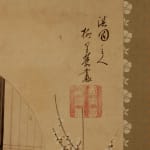Yanagisawa Kien
New Year Chanoyu , mid-18th century
Hanging scroll; ink, mineral pigments, and gofun (clam-shell gesso) on paper in silk mounts, depicting a seated woman preparing tea
Image Size 18¼ x 19¾ in. (46.3 x 50.7 cm)
Overall Size 56 x 26¼ in. (142 x 66.5 cm)
Overall Size 56 x 26¼ in. (142 x 66.5 cm)
T-0544
Further images
Signed at top right 'Painted by Kien Shujin [Master of the Qi River Garden] Ryū Rikyō' and with large square seal Ryū Rikyō, Chinese name Kōbi In this unusual composition,...
Signed at top right 'Painted by Kien Shujin [Master of the Qi River Garden] Ryū Rikyō' and with large square seal Ryū Rikyō, Chinese name Kōbi
In this unusual composition, a Japanese woman is viewed through a circular window in the side of a tea-hut where she sits with a water ladle in her right hand in the act of taking hot water from a tea kettle. The presence of the kettle is suggested both by the ladle and by the partially visible robuchi, a frame of lacquered wood placed around the edge of a sunken recess in the tatami matting that houses the kettle supported on a trivet above glowing charcoal; the tea guests are no doubt seated on the other side of the robuchi, waiting to receive the teabowl placed in front of the woman. The other utensils are the tea scoop placed atop the container for powdered matcha tealeaves and the tea whisk, used to mix hot water and powdered tea into a frothy, dark-green liquid. A flowering branch of plum outside the room establishes the season as New Year or early spring.
Born into the wealthy Yanagisawa samurai clan but later assuming the Chinese-style name Ryū Rikyō, this artist started his training in the immensely influential Kano official painting academy but later studied and copied the style of painting associated with Chinese artists who spent brief periods of time in the port town of Nagasaki in Kyushu, Japan’s southernmost main island; this style is especially apparent in the depiction of the flowering plum branches in the foreground of the present scroll.
In this unusual composition, a Japanese woman is viewed through a circular window in the side of a tea-hut where she sits with a water ladle in her right hand in the act of taking hot water from a tea kettle. The presence of the kettle is suggested both by the ladle and by the partially visible robuchi, a frame of lacquered wood placed around the edge of a sunken recess in the tatami matting that houses the kettle supported on a trivet above glowing charcoal; the tea guests are no doubt seated on the other side of the robuchi, waiting to receive the teabowl placed in front of the woman. The other utensils are the tea scoop placed atop the container for powdered matcha tealeaves and the tea whisk, used to mix hot water and powdered tea into a frothy, dark-green liquid. A flowering branch of plum outside the room establishes the season as New Year or early spring.
Born into the wealthy Yanagisawa samurai clan but later assuming the Chinese-style name Ryū Rikyō, this artist started his training in the immensely influential Kano official painting academy but later studied and copied the style of painting associated with Chinese artists who spent brief periods of time in the port town of Nagasaki in Kyushu, Japan’s southernmost main island; this style is especially apparent in the depiction of the flowering plum branches in the foreground of the present scroll.











